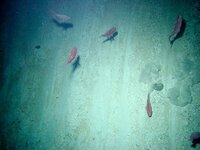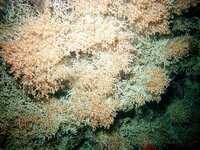It's only fair that both sides of the story are presented:
Greenpeace assault on a New Zealand fishing vessel
Greenpeace assault on a New Zealand fishing vessel
Thursday, 9 June 2005, 12:38 pm
Press Release: Seafood Industry Council
9 June 2005
“Greenpeace’s assault on a New Zealand fishing vessel this week in the Tasman was dangerous and disgraceful. It is entirely appropriate that the Government considers what action it can take to protect New Zealanders legally going about their business wherever they are,” says New Zealand Seafood Industry Council chief executive Owen Symmans.
“The facts are the fishing techniques utilized by the New Zealand industry minimises impact on the biodiversity of the ocean bottom where fishing takes place. New Zealand fishers simply do not drag heavy trawl gear across pristine sea floor as suggested. Technology allows boats to ‘fly’ trawl gear above the sea bottom to target the fish, with little impact on the sea floor or organisms that live on the bottom. Fishing only occurs in a very small area of ocean, which has generally been fished for many years. Much of the area cannot be fished because of the size, slope and structure of the sea floor.
“New Zealand fishing companies operate within the most effective sustainable fishing management system in the world. Indeed Greenpeace themselves identified New Zealand bottom trawlers as ‘good operators’1 in a March 2005 case study.
“Clearly it is in the best interests of the fishing industry to protect the ocean habitat because that is the best way of ensuring there will be fish to catch. The New Zealand seafood industry invests heavily in research and technology to minimise the impact of bottom trawling with significant success and this investment will continue into the future,” says Mr Symmans.
The claim New Zealand fish stocks are at risk is misleading, said Mr Symmans. Independent assessments contracted by the Ministry of Fisheries to instruct the Minister when making decisions about how much fish can be caught show this is not the case, he said.
ENDS
August 04 Background Information
Bottom Trawling in the New Zealand EEZ and in the High Seas
NZ EEZ
Trawling is by far the most common fishing method used to catch fin fish in the New Zealand EEZ.
With the exception of bottom long lining, trawling is the only method used by New Zealand fishing operators to catch deep water fish species in the high seas.
Scallops, oysters and scampi are also harvested using dredging or trawling.
SeaFIC estimates that over $800 million of the $1.2 billion earned from seafood exports in 2003 was from species caught by trawling and related bottom methods. This is similar to global fisheries statistics. Globally, about 70% of fish and shellfish production comes from trawl fishing.
Most of the 26,000 jobs that the seafood industry has created in New Zealand relate directly or indirectly to trawl fishing. The only exceptions are for people employed in aquaculture, longline fishing and rock lobster and paua harvesting.
New Zealand fisheries are managed sustainably through the Quota Management System. This ensures that catch limits are set to ensure long term sustainability and provide strong incentives for quota holders to fish responsibly.
More than 65% of the New Zealand EEZ cannot be fished by trawling, because areas are closed to trawling, the water is too deep or there are no fish present of commercial interest.
The remaining 35% available for trawling is only fished where the sea bottom terrain is suitable and where fish can be located. Fishing therefore takes place only in selected areas. Fishers generally fish in similar areas each year which means that new areas are not being damaged.
High Seas
Outside the EEZ in the high seas, trawling for deep water species can only take place in a very small area of suitable terrain at depths between 800 to 1200 metres.
Globally and in New Zealand, most bottom trawl fishing takes place on a flat or undulating sea bottom generally covered in muddy sediment. This is generally not a suitable habitat for corals. Trawling in these areas will come into contact with and disturb the bottom sediments. However the ecosystem impact is minimal.
Deep water trawling for species like orange roughy takes place on undersea slopes, mounds and seamounts. The terrain is sometimes rocky and can be a habitat for cold water corals. New Zealand deepwater fishers have modified their fishing techniques to minimise contact with slope surfaces. This lessens the impact on both the sea floor and fishing gear.
Trawl gear cannot be deployed on slopes of greater than 20 degrees. Much of the deepwater slope and seamount terrain cannot be fished as it is too steep, thus avoiding any chance of contact with corals. More of the deepwater slopes and seamount terrain is not fished than is fished.
Deepwater species like orange roughy commonly aggregate in plumes above slopes. Fishers will bring fishing gear down on such aggregations in a broad arc, and thus minimize the period where gear might come into contact with the sea floor.
It is a complete misrepresentation of deep water trawling for orange roughy to assert that it is conducted by rolling and crushing trawl gear indiscriminately across the sea floor.

 on top of his boat, cracking the whip to *ahem* motivate? his students to tow the boat faster.... *shivers*
on top of his boat, cracking the whip to *ahem* motivate? his students to tow the boat faster.... *shivers* 
